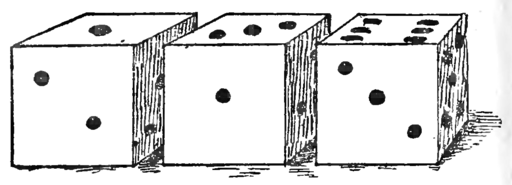| Español | English |
Los problemas, relacionados con las sumas de los valores de tiradas de dados, son muy populares en las matemáticas recreativas. Afrontaremos su resolución desde el punto de vista del análisis combinatorio.
La suma de dados puede considerarse como un caso particular de un problema más general. Dado un entero N , determinar el número de particiones posibles del mismo en k sumandos, elegidos de entre m valores n1 ... nm , siendo el orden de los sumandos importante.
La solución a este problema, el coeficiente de x N en la expansión de la expresión ( x n1 + x n2 + ... + x nm ) k .
En el caso particular que nos ocupa,
x k ∙ ( 1 + x + x 2 + x 3 + x 4 + x 5 ) k
x k ∙ ( 1 − x 6 ) k
( 1 − x ) k―――――――――――――
Centremos nuestra atención en el cociente ( 1 − x 6 ) k ∙ ( 1 − x ) -k , realizando la expansión de las potencias de los polinomios podemos construir un triángulo aritmético, generalización del triángulo de Pascal .
k = 1 1 1 1 1 1 1 0 ...
k = 2 1 2 3 4 5 6 5 4 3 2 ...
k = 3 1 3 6 10 15 21 25 27 27 ...
Filas indexadas por el valor k y las columnas lo son por ( N − k ).
Podemos determinar el valor, de cada uno de los elementos, como la suma de los seis valores en la fila inmediatamente anterior por encima y a la izquierda del valor deseado.
Definiendo D ( k , n ) como la solución al problema de la suma de dados para k tiradas con suma ( N − k ),
D ( k , n ) = ∑ D ( k − 1, n − i )
0
D ( k , 0 ) = 1
D ( k , n ) = 0 , n > 5 ∙ k
D ( k , n ) = 0 , n < 0
D ( k , n ) = D ( k , 5 ∙ k − n )
Estas ecuaciones permiten construir una solución recursiva al problema de la suma de dados.
Por otra parte, cada coeficiente es la suma de como máximo k valores, fruto del producto de los coeficientes de los monomios de exponente ( 6 ∙ m ) y ( N − k − 6 ∙ m ), 0 ≤ m < k , n = N − k − 6 m ,
sumando ( k , N , m ) = 0 , n < 6 ∙ m
Donde, C ( a , b ) es el coeficiente binomial , a sobre b .
Estas ecuaciones nos permiten construir una solución iterativa.
∎
| English | Español |
Problems on sums of throwing dice are very popular in recreational mathematics, let's solve these from a combinatorial standpoint.
Dice sums are a particular case of a more general problem. A positive integer N given, calculate the number of partitions in k addends, choosen from m values n1 ... nm , with regard for the order of the summands. The coefficient of x N in the expansion of the expression ( x n1 + x n2 + ... + x nm ) k is the solution to this problem.
In our particular problem,
x k ∙ ( 1 + x + x 2 + x 3 + x 4 + x 5 ) k
x k ∙ ( 1 − x 6 ) k
( 1 − x ) k―――――――――――――
Take the quotient ( 1 − x 6 ) k ∙ ( 1 − x ) -k , expanding the polynomial powers an arithmetic triangle, generalization of Pascal's triangle , shows up.
k = 1 1 1 1 1 1 1 0 ...
k = 2 1 2 3 4 5 6 5 4 3 2 ...
k = 3 1 3 6 10 15 21 25 27 27 ...
Rows indexed by k value, columns by ( N − k ).
Value of any element can be calculated as the sum of the six values up and to the left of its own position.
Denoting by D ( k , n ) the solution to the problem of dice sums on k throwings with sum ( N − k ),
D ( k , n ) = ∑ D ( k − 1, n − i )
0
D ( k , 0 ) = 1
D ( k , n ) = 0 , n > 5 ∙ k
D ( k , n ) = 0 , n < 0
D ( k , n ) = D ( k , 5 ∙ k − n )
These equations allow us to build up a recursive solution to the problem of dice sum.
On the other hand, each coefficient is tne sum of upto k values, these as the product of coefficients in terms of factors with exponents ( 6 ∙ m ) and ( N − k − 6 ∙ m ), 0 ≤ m < k , n = N − k − 6 m ,
addend ( k , N , m ) = 0 , n < 6 ∙ m
Where, C ( a , b ) is the binomial coefficient , a choose b .
These equations allow us to build up an iterative solution.
∎

Congratulations @j2e2xae! You have completed the following achievement on the Hive blockchain And have been rewarded with New badge(s)
Your next target is to reach 1500 upvotes.
You can view your badges on your board and compare yourself to others in the Ranking
If you no longer want to receive notifications, reply to this comment with the word
STOP